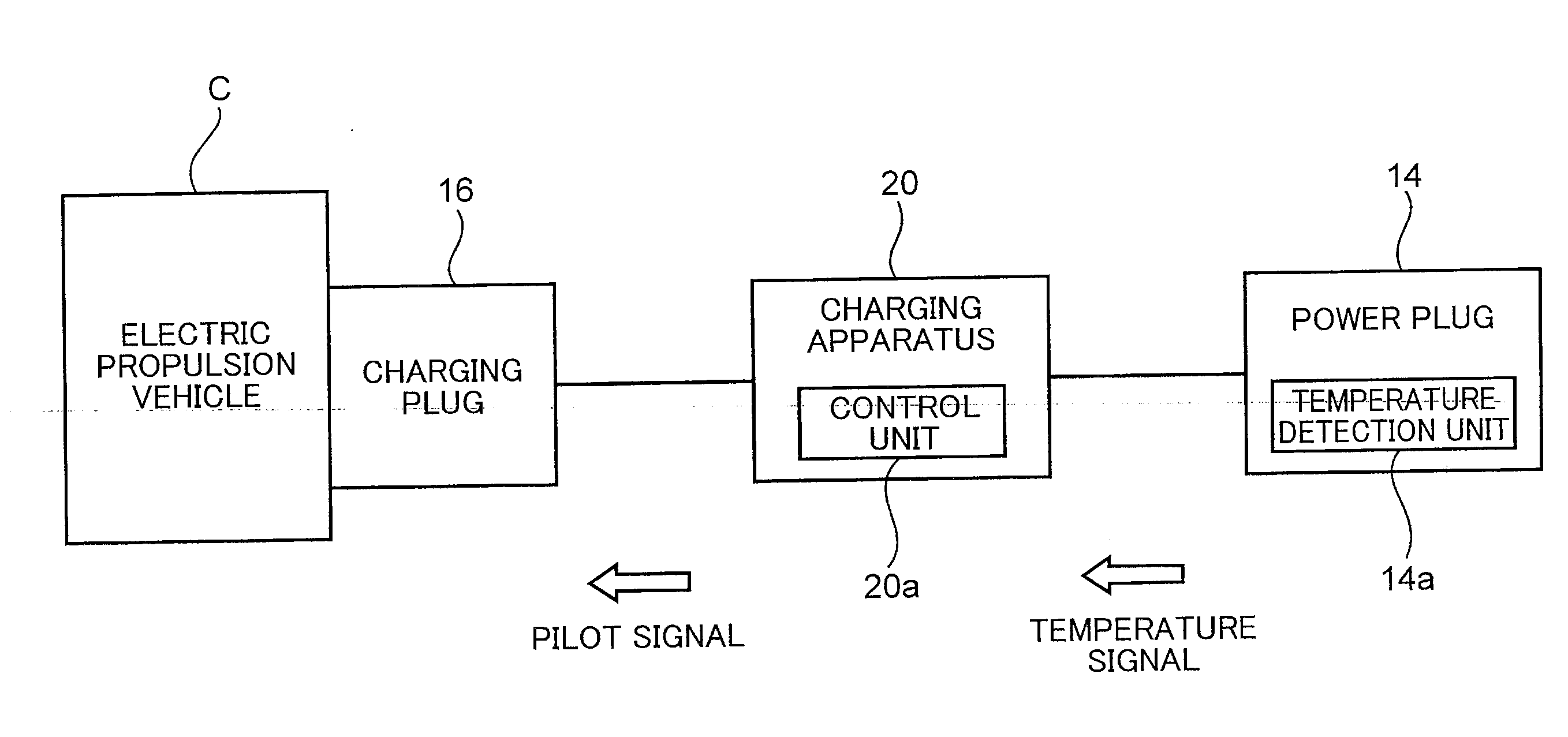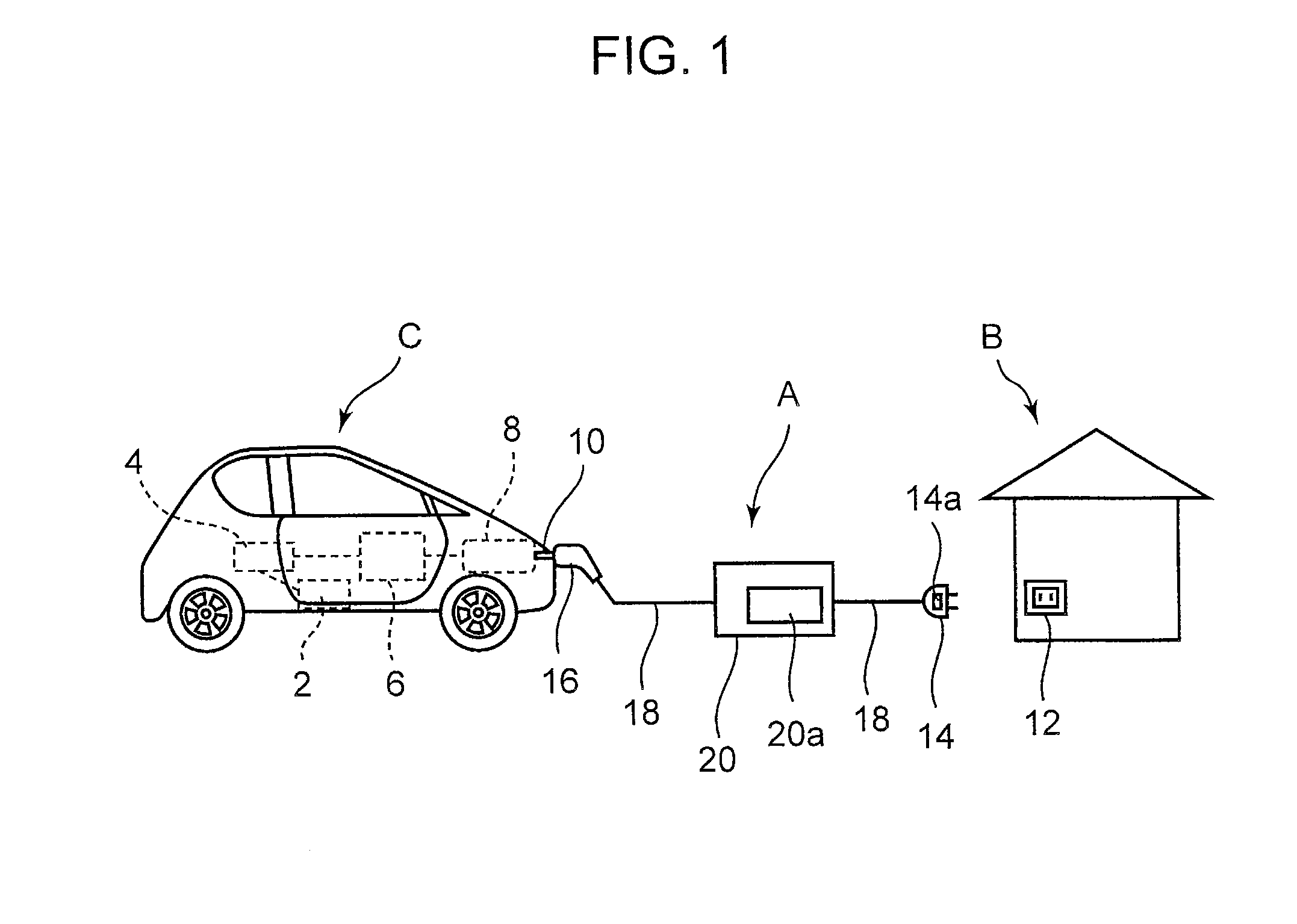Charging cable
- Summary
- Abstract
- Description
- Claims
- Application Information
AI Technical Summary
Benefits of technology
Problems solved by technology
Method used
Image
Examples
embodiment 1
[0023]Embodiment 1 of the present invention will be described below with reference to the drawings. FIG. 1 is a diagram of a general configuration of a charging system to which a charging cable A for an electric propulsion vehicle according to Embodiment 1 of the present invention is applied. In the charging system, an electric propulsion vehicle C is powered using a commercial power supply at a standard home B via the charging cable A, to charge a battery 6 for the electric propulsion vehicle C.
[0024]As shown in FIG. 1, the electric propulsion vehicle C includes a drive motor 2, an inverter 4, the battery 6, and a charging control apparatus 8. The drive motor 2, the inverter 4, the battery 6, and the charging control apparatus 8 are electrically connected together. The electric propulsion vehicle C is connected to the charging cable A via a connector 10 connected to the charging control apparatus 8.
[0025]The drive motor 2 is a motor that drives the electric propulsion vehicle C. Th...
embodiment 2
[0053]The charging cable A according to Embodiment 2 is characterized by avoiding the recovery of the electric conduction to the battery 6 even when the detected temperature decreases to the specified temperature T2 or lower if the detected temperature during the period of electric conduction has a temperature gradient equal to or larger than a predetermined specified temperature gradient. Components of Embodiment 2 which are the same as the corresponding components of Embodiment 1 are denoted by the same reference numerals and will not be described.
[0054]Control according to Embodiment 2 will be described using FIG. 4. In Embodiment 2, the control unit 20a calculates the temperature gradient during a period of electric conduction TM1. Each time the temperature detection unit 14a transmits a detected temperature to the control unit 20a during the period of electric conduction TM1, the control unit 20a determines the difference between the currently transmitted detected temperature a...
embodiment 3
[0058]The charging cable A according to Embodiment 3 is characterized by reducing the conduction current compared to a value used before the stop of the electric conduction to the battery 6 when the electric conduction is to be recovered. Components of Embodiment 3 which are the same as the corresponding components of Embodiments 1 and 2 are denoted by the same reference numerals and will not be described.
[0059]FIG. 5 are waveform diagram showing a control sequence for the charging cable A according to Embodiment 3 of the present invention. FIG. 5A shows the temporal transition of the detected temperature, and FIG. 5B shows the temporal transition of the conduction current. In FIG. 5A, the axis of ordinate indicates the detected temperature, and the axis of abscissas indicates time. In FIG. 5B, the axis of ordinate indicates the conduction current, and the axis of abscissas indicates time.
[0060]FIG. 5A and FIG. 5B are the same as FIG. 4A and FIG. 4B in that the electric conduction i...
PUM
 Login to view more
Login to view more Abstract
Description
Claims
Application Information
 Login to view more
Login to view more - R&D Engineer
- R&D Manager
- IP Professional
- Industry Leading Data Capabilities
- Powerful AI technology
- Patent DNA Extraction
Browse by: Latest US Patents, China's latest patents, Technical Efficacy Thesaurus, Application Domain, Technology Topic.
© 2024 PatSnap. All rights reserved.Legal|Privacy policy|Modern Slavery Act Transparency Statement|Sitemap



